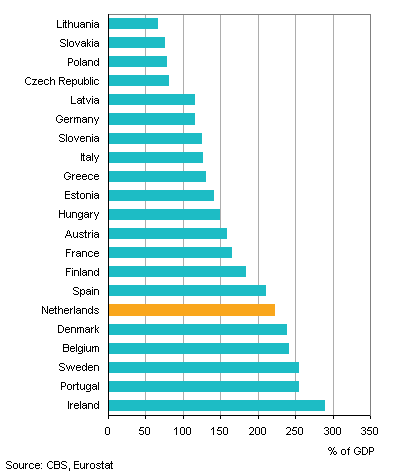Household debt marginally down

The total debt of households and non-financial companies amounted to more than 1.3 trillion euros by the end of June, i.e. 223.7 percent of the GDP. This so-called private debt-to-GDP ratio was marginally below the level of the preceding quarter (224.0 percent). This is predominantly due to the fact that the overall household mortgage debt was marginally reduced. The total corporate debt hardly changed.
Household debt marginally down for third consecutive quarter
The private debt-to-GDP ratio is one in a set of eleven indicators in the macro-economic scoreboard, used by the European Commission to identify macro-economic imbalances in a country. Apart from loans (largely residential mortgages) of households, the private sector debt also includes loans, bonds, derivatives and short-term securities of non-financial partnerships.
In the second quarter, the household debt-to-GDP ratio was marginally reduced. By the end of June, the total debt of Dutch households was 127.4 percent of GDP, versus 127.8 percent by the end of March. The household debt-to-GDP ratio fell slightly for the third time in a row. The debt-to-GDP ratio of non-financial partnerships hardly changed and stood at 96.3 percent by the end of June. It has ranged between 90 and 100 percent for years.
Private sector debt

Mortgage debt households somewhat down
The bulk of household debts consists of residential mortgages. By the end of June, the residential mortgage debt totalled 669.3 billion euros by the end of June, versus 671.3 billion euros in the first quarter. The mortgage debt of households has declined for three quarters now, though only marginally. The mortgage debt has grown substantially between 1995 and mid-2012.
Residential mortgages and total loan amount households

Private debt in the Netherlands and various other Western European countries above EU limit
The private debt-to-GDP ratio in the Netherlands of 223.7 percent in June 2013 was far above the EU limit of 160 percent. Various other Western European countries also overstepped the EU limit. By the end of 2012 – the most recent year for which figures are available – the private debt-to-GDP ratios in Ireland, Sweden, Portugal, Belgium and Denmark were higher than in the Netherlands. Unlike in the Netherlands, the debt-to-GDP ratio of non-financial partnerships was notably high in these countries. Denmark was the only country to have a higher household debt-to-GDP ratio than the Netherlands.
Private debt-to-GDP ratio, end of 2012

European Commission monitors private sector debt
Since 2011, the European Commission has monitored the eleven macro-economic indicators. In April 2013, the Commission concluded that the private debt requires attention, because the high household debt creates a risky situation for mortgage debtors and mortgage creditors alike. Yet, the European Commission saw no reason to take action. In the autumn, the Commission will re-evaluate economic developments.
Wouter Jonkers